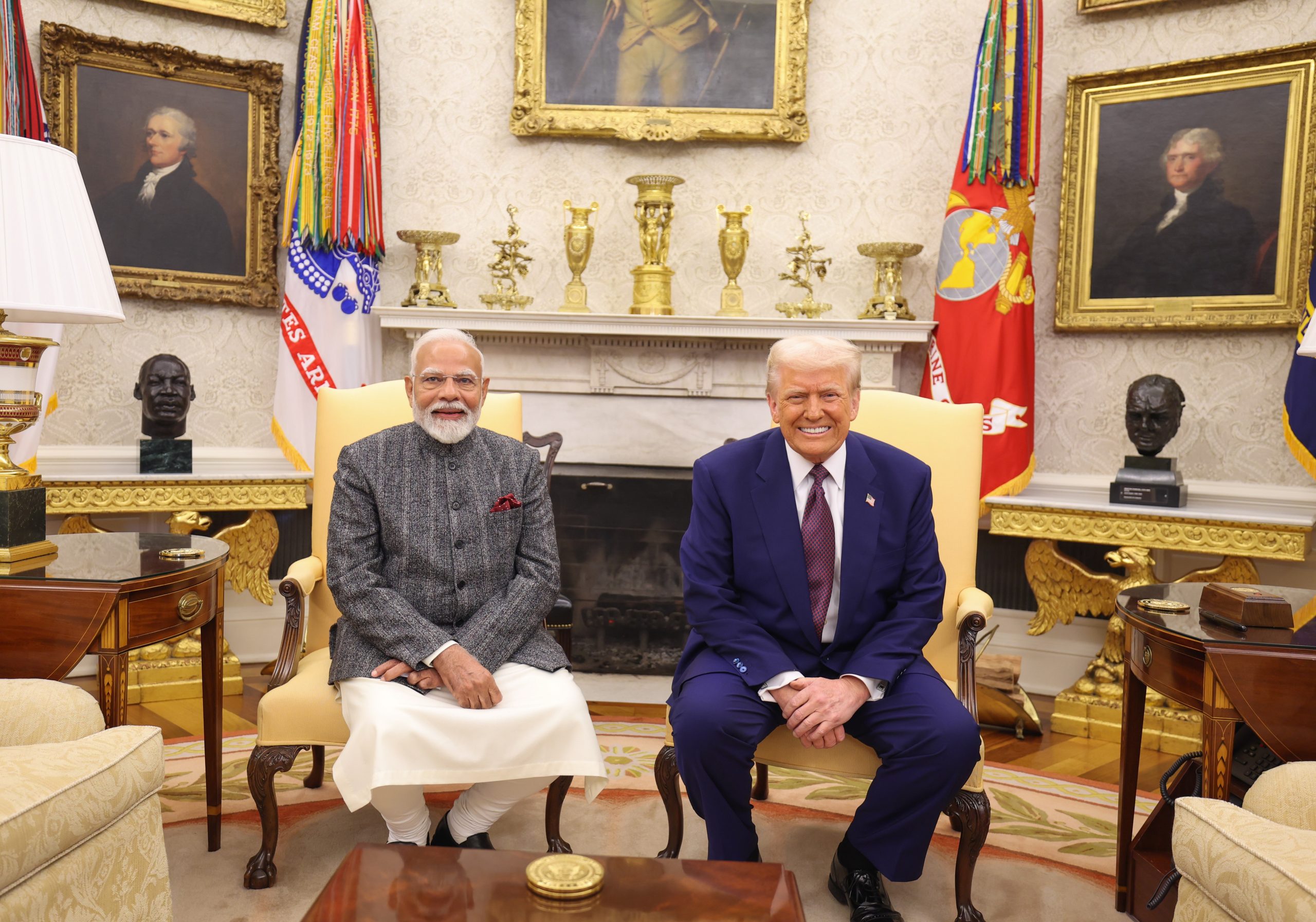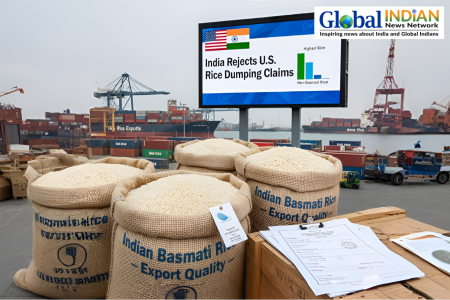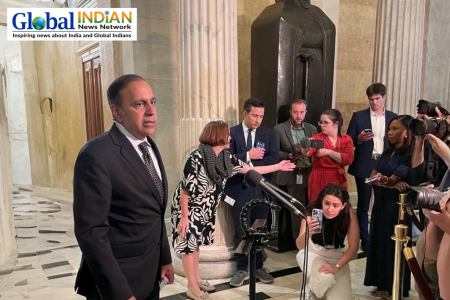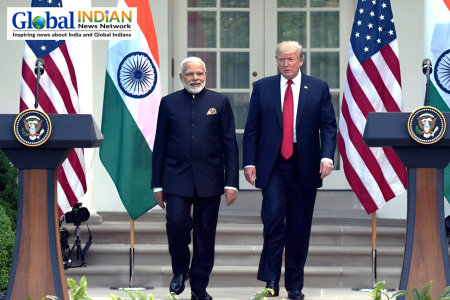US-India Relations under Trump 2.0
India believes it is well-positioned to navigate a second Trump administration and that U.S.-India relations will continue to deepen. PM Modi meets the President of USA, Mr. Donald Trump at White House – File Photo
PM Modi meets the President of USA, Mr. Donald Trump at White House – File Photo
By David Sacks and Paul B. Stares
We recently returned from one week of meetings in New Delhi with a range of think tank experts, academics, and government officials. Our visit occurred following the Oval Office confrontation between Ukraine’s President Volodymyr Zelenskyy and President Donald Trump and coincided with negotiations between the United States and Ukraine in Saudi Arabia. The prospect of a U.S.-Russia rapprochement and a U.S.-China deal dominated our conversations. Below are five principal takeaways of what we heard about U.S.-India relations, how India sees its role in the Indo-Pacific, and how it plans to navigate a second Trump administration.
India views Trump’s pivot toward Russia as a vindication of its stance on the war in Ukraine.
Following Russia’s invasion of Ukraine in February 2022, India refrained from signing on to multilateral sanctions and instead took advantage of the low price of Russian oil. Whereas Russian crude oil accounted for only one percent of India’s oil imports on the eve of the war, this has now surged to 40 percent, and Russia is currently India’s top supplier of crude oil. Russia and India also have a long-standing security relationship, with Russian equipment accounting for over 60 percent of India’s military hardware. Indian elites describe Russia as a trusted, reliable partner, with one scholar even describing Moscow to us as a “beacon of light.”
Given this close relationship, New Delhi resisted the Biden administration’s pressure to denounce Russia’s invasion of Ukraine and to not provide Moscow with an economic lifeline. With Trump’s return to power and his pivot to Russia, India is happy that it will not face continued pressure to cut ties with Russia. Indian analysts argued that the U.S.-led effort to isolate Russia backfired, driving the Kremlin into China’s arms. Instead, they support a more accommodative policy that they believe can halt or even reverse this trend.
The lesson that India is learning from U.S.-Russia rapprochement, however, could undermine efforts to bolster deterrence in East Asia. India may conclude that any U.S.-led sanctions on China and attempt to isolate Beijing in a conflict over Taiwan would be similarly short-lived, and that it would be best served by again being cautious and avoiding taking sides. In a similar vein, we observed little reckoning with how the erosion of norms against the use of force and the attempt to unilaterally redraw borders could undermine India’s security interests over the long term.
The 2020 border clash between India and China fundamentally changed their relationship, and the recent thaw does not change India’s strategic assessment of China.
We found little daylight among our interlocutors when it came to China. Nearly all of them spoke of the June 2020 border clash between India and China in the Galwan Valley as an inflection point for the bilateral relationship, leading Indians to view China as a hostile power and the country’s most serious long-term strategic challenge.
While India and China stabilized their relationship in October 2024 with an agreement to disengage along the disputed border, this was described as a tactical move that both sides deemed necessary for a similar reason: assessing that there will be more unpredictability out of Washington under President Trump, they concluded that it was in their interest to deescalate and put aside one area of friction.
Despite the recent thaw, the underlying irritants of the India-China relationship are not going away. Their shared border remains contested and the de-escalation is not seen as a long-term solution. More fundamentally, India resents China’s substantial and growing influence in South Asia – above all in Pakistan, but also in Nepal, Sri Lanka, and the Maldives – a region that it regards as its backyard.
Indian elites, despite viewing China as the country’s primary strategic rival, still focus primarily on the country’s immediate periphery in South Asia.
Despite a broad consensus that China is India’s long-term strategic rival, there was little consideration for how Chinese actions in East Asia would impact India’s interests. For instance, many voiced the opinion that India would be insulated from a war over Taiwan and, therefore, the country should not be asked to play a larger role in deterring Chinese aggression against the island or to contribute to a response if deterrence fails. Indian elites held this view despite estimates that India’s economy would sharply contract during a war over Taiwan and take a larger hit to its GDP than the United States.
Multiple interlocutors spoke of India’s capacity constraints and argued that even if the country took a broader view of its interests, it did not have the diplomatic infrastructure or the military power to defend those interests. Instead, it would continue to expend most of its energy and resources on South Asia, while remaining open to multilateral cooperation with countries in the Asia-Pacific.
To that end, while there is little appetite for playing a major role in East Asia, India is open to further expanding bilateral security cooperation with the United States.
Sentiment toward the Quad (a grouping of Australia, India, Japan, and the United States) was more bullish than we anticipated, with the partnership seen as an important tool for addressing regional security issues. There is appetite for increasing U.S.-India security cooperation and for focusing the Quad more squarely on security issues. The U.S.-India Joint Leaders’ Statement that came out of Modi’s February visit to Washington, which emphasized defense and security issues and put forward ambitious goals, is seen as a good starting point rather than the highest that both countries can go.
Bilateral cooperation in this realm could well range from increasing interoperability to defense industrial cooperation, licensing and joint production of equipment, and logistical support for U.S. forces in the Indo-Pacific.
India is confident in its ability to navigate the second Trump administration.
We heard satisfaction with Prime Minister Modi’s visit to Washington and his meetings with President Trump. Given the strong personal connection between Trump and Modi and converging strategic interests, Indians believe the country is in a good strategic position.
While the United States has an annual trade deficit of $45.6 billion with India and the country is one of the most vulnerable to reciprocal tariffs – India’s tariffs on imports average 14 percent, more than double China’s average – we heard optimism that India would be able to preempt such actions by lowering tariffs on a range of U.S. imports. There was hope that since the United States is India’s largest trading partner, Washington would demonstrate more flexibility in its approach to its trade relationship with New Delhi. Indians also pointed to the declining share of its arms imports from Russia and the growing share of imports from the United States, which may shrink the trade deficit in the coming years and more importantly demonstrates the closer bilateral security ties that can add ballast to the relationship.
The one qualifier to this optimism is the fear that the United States and China will reach a grand bargain that fundamentally resets the U.S.-China relationship and creates a “G2” condominium. Such a scenario would leave India in a vulnerable position, forcing it to navigate its strategic competition with China alone.
About the Authors
David Sacks is a fellow for Asia studies at the Council on Foreign Relations (CFR), where his work focuses on U.S.-China relations, U.S.-Taiwan relations, Chinese foreign policy, cross-Strait relations, and the political thought of Hans Morgenthau.
Paul B. Stares is the General John W. Vessey senior fellow for conflict prevention and director of the Center for Preventive Action at the Council on Foreign Relations (CFR).













